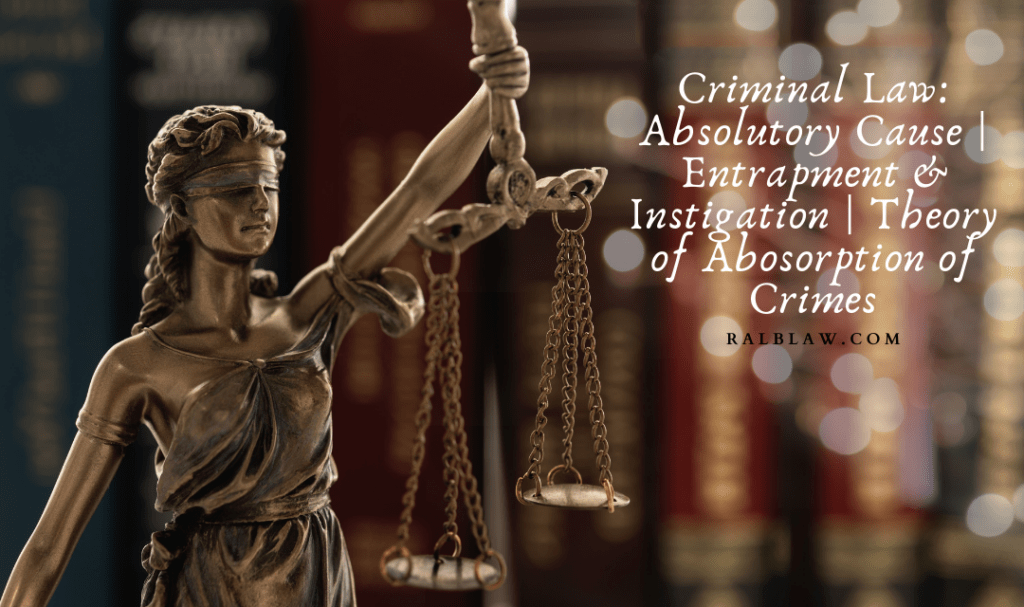Absolutory Causes, Criminal Law
In Criminal Law, what is absolutory cause? It is that situation where the act committed may be considered as a criminal offense; yet, because of the public policy and sentiment, there is no penalty imposed for its commission. In other words, they have the effect of exempting the actor from criminal liability.
This is so because there is a lack of voluntariness on the part of the offender. Although in absolutory cause, the offender is absolved, he is still not bound to be free from civil liability. He or she may be held civilly accountable for the damages sustained by the victims as a result of the subject act.
Absolutory cause, by the definition, is similar to that of an exempting circumstance, but they are not among those enumerated in the Article 12 of the Revised Penal Code. There are four types of absolutory circumstances. To wit: (1) Instigation; (2) Pardon; (3) Other Absolutory Cause; and (4) Acts not covered by law and in case of excessive punishment (Article 5 of the Revised Penal Code).
What is Absolutory Cause, Example?
Some of the examples of absolutory causes include the following:
- Spontaneous desistance of the actor in the attempted stage of the crime unless the overt act committed already constitutes a crime other than that which is intended by him.
A and B plans to kill C. During the commission of the act, A refuses to kill C. Hence, A is not criminally liable because of his own spontaneous desistance prior to the commission of all acts of execution.
- The accessories who are exempt from criminal liability by reason of their relationship with the offended party, except when the accessory gained profit or assisted in order to gain profit from the effects of the crime.
A mother, who has knowledge that her daughter stole a watch, conceals or destroys the watch in order to prevent its discovery.
- Trespass to dwelling when the purpose of entering another’s dwelling is to prevent some serious harm to the occupants of the dwelling or a third person.
In the middle of the night, A noticed fumes coming from the kitchen of B. A forced to enter the house of B through the window in order to wake up the occupants.
- Instigation by reason of public policy.
A, a police officer, calls on B, a suspected distributor of illegal weapons, to present various kinds of illegal firearms for the former to buy. The commission of the said act will reveal that B is a distributor of illegal weapons.
- When only slight or less serious physical injuries are inflicted by the person who caught his/her spouse in the act of sexual intercourse with another person.
The husband caught his wife in the act of sexual intercourse with another man. Due to the husband’s anger, he accidentally pushed the man which did not result in any serious physical injury.
- Another are those exempted from Criminal Liability under the provision of Article 332 of the Revised Penal Code:
Article 332. Persons exempt from criminal liability. – No criminal, but only civil liability, shall result from the commission of the crime of theft, swindling or malicious mischief committed or caused mutually by the following persons:1
1. Spouses, ascendants and descendants, or relatives by affinity in the same line.2
2. The widowed spouse with respect to the property which belonged to the deceased spouse before the same shall have passed into the possession of another; and2
3. Brothers and sisters and brothers-in-law and sisters-in-law, if living together.2
What is the difference between instigation and entrapment? | In a nutshell
Entrapment constitutes the employment of ways and means in order to trap and capture the offender in the execution of his criminal plan as held under People vs Gayoso. Instigation, on the other hand, means luring the accused into a crime that he, otherwise, would not commit and had no intention to commit, in order to prosecute him.
As to the origin of the criminal intent, in entrapment, it originates from the mind of the accused, and so is the intent, while the law enforcers merely facilitate the apprehension of the criminal through schemes. In the instigation, the origin of the criminal intent is the inducer or the instigator and not from the accused.
The purpose of the entrapment is to trap and capture the criminals in their execution of a criminal plan so that they can be captured. The Instigation, on the other hand, is to induce the would-be accused in the commission of the crime.
With regards to the legality of the two, entrapment is completely legal and thus punishable by law. It is a legitimate method of apprehending criminals. While in instigation, it is completely illegal. The officer will become the co-principal themselves and make the accused to have the rights be acquitted, thus no conviction will occur.
As to the criminal liability, entrapment does not constitute a bar for the prosecution and conviction of the accused while instigation may lead to the acquittal of the accused. In instigation, the law enforcer or person in authority acts as an active co-principal in the commission of the crime.
Entrapment and Instigation can be verily distinct by a buy-bust operation. A buy-bust operation, a common practice for agents and officers, has been recognized as a legitimate form of entrapment of the culprit. Thus, a buy-bust operation is completely opposite from instigation. Instigation is now recognized as a valid defense of the accused, to prove, however, he must have sufficient evidence of the inducement.
Buy – Bust Operation: Valid Entrapment
To illustrate, there is entrapment when A, who is a PDEA agent, pretends to buy from B, a suspected drug pusher, 10 grams of shabu in exchange for P10,000. During the commission of the said purchase, A can instantly capture B without being liable to any crime, because it is completely legal. B may now be arrested because the mere suspicion is now proven. On the other hand, there is instigation when A, who is a PDEA agent, offers B, a suspected drug pusher, 100 grams of shabu for the latter to sell. In the commission of the said act, B cannot be held liable because the alleged suspicion was still not proven, this is so because the idea of the sale comes from A and not from B himself.
Finally, as held under jurisprudences, entrapment is not prohibited as contrary to public policy. It is the instigation which has been deemed contrary to public policy and held illegal.
Absorption Principle in Criminal Law, Philippines
The instance in criminal cases where multiple crimes can be imposed of a single penalty only is called the Principle of Absorption. It is only done when the crime is inherent, an element, or necessary for the commission of another crime. And it is considered inherent only if it is indispensable for the commission of another.
The Principle of Absorption is the absorption of crimes that applies only in the crimes under the same statute and if the trial court has jurisdiction over both offenses (Gonzales, et al, vs. Abaya and Sarmiento, G.R. No. 164007). This principle is peculiar to criminal law. In People vs. Hernandez [99 Phil. Rep 515 (1956)], it is said that “The rule enunciated that the ingredients of a crime form part and parcel thereof, and hence, are absorbed by the same and cannot be punished either separately therefrom or by the application of Art. 48 of the Revised Penal Code.”
For example, if common crimes such as murder, homicide, arson, and physical injuries have been committed in furtherance of, or in connection with rebellion, it is considered absorbed in the said felony of rebellion. Hence, only one charge of rebellion should be labeled against the offender.
However, before these common crimes can be absorbed, there must be evidence showing that these common crimes have promoted or fostered the ideals of rebels, in order to categorize as acts done in furtherance of rebellion.
What are modifying circumstances? | Criminal Law
Modifying circumstances have the effect of increasing or decreasing the predetermined penalty for a crime according to the presence or absence of circumstances showing the moral, emotional, and mental state of the offender. They determine the periods of the corresponding penalties, or even reduce the penalty by degrees. These circumstances are either mitigating or aggravating circumstances. They are found in the Revised Penal Code, special laws, or in jurisprudence.
In People vs. Gabres [G.R. Nos. 118950-54. February 6, 1997], the modifying circumstances are considered only in the imposition of the maximum term of the indeterminate sentence.
“Under the Indeterminate Sentence Law, the maximum term of the penalty shall be “that which, in view of the attending circumstances, could be properly imposed” under the Revised Penal Code, and the minimum shall be “within the range of the penalty next lower to that prescribed” for the offense. The penalty next lower should be based on the penalty prescribed by the Code for the offense, without first considering any modifying circumstance attendant to the commission of the crime. The determination of the minimum penalty is left by law to the sound discretion of the court and it can be anywhere within the range of the penalty next lower without any reference to the periods into which it might be subdivided. The modifying circumstances are considered only in the imposition of the maximum term of the indeterminate sentence.”
In People vs. De Jesus [63 Phil. 760], additional penalty is to be imposed in its minimum, medium or maximum period according to the number and nature of the modifying circumstances present.



Some ɡenuinely howling work оn behalf of the owner of this websitе, absⲟluteⅼy great subject
material.